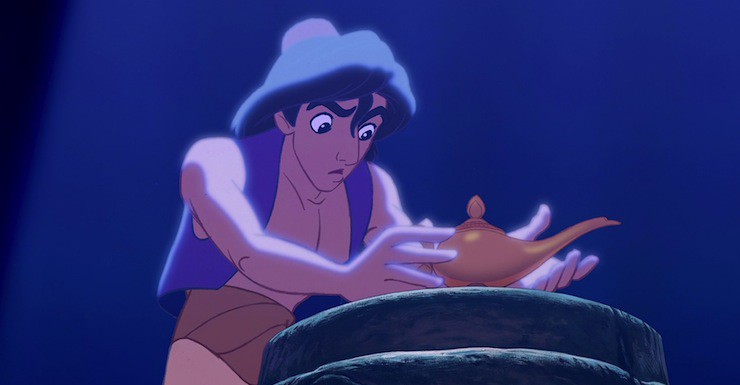Ron Clements and John Musker knew immediately what they wanted to do after The Little Mermaid. Pirates! In! Space! They had, after all, been pitching it to Disney for years by this point, and the success of The Little Mermaid would, surely, let them pursue their dream.
Alas, then chairman of Walt Disney Pictures Jeffrey Katzenberg was not a pirate sort of guy. He did, however, console the successful writer/directors with a tempting offer: they could choose to work on any of the three projects then in development: a little movie about a lion, an adaptation of Swan Lake, and this, well, little thing about Aladdin that lyricist Howard Ashman had been playing with when not obsessed with mermaids, roses, and beasts. Crushed, but impressed by Ashman’s songs, and liking the potential humor of the piece, Clements and Musker agreed to come on board for Aladdin.
Tragically, by the time they came on board, Howard Ashman was in the final stages of AIDS, and unable to collaborate much on Aladdin. Still, he had written a few songs for the film, and with those, Clements and Musker cobbled together a script and storyboards, bringing it to Katzenberg about a month after Ashman’s death.
Katzenberg was not impressed, and demanded a complete overhaul. Clements and Musker brought in two new screenwriters, and took another stab at the story, making multiple changes. In the original version, for instance, as in the original fairy tale, the Genie was able to grant unlimited wishes. In the new version, the Genie could only grant three wishes per person—and those wishes came with some restrictions. That had the decided benefit of forcing Aladdin to use his wits, instead of the Genie, to defeat Jafar (and eliminate the pesky question of “Why didn’t Aladdin just grab the lamp and tell the Genie to bury Jafar in a cage?”). It also made Aladdin’s last wish, to free the Genie, more meaningful—since this also meant giving up his only possible remaining wish, and thus his chance to once again be a prince. Alas, it also meant dropping one of Howard Ashman’s original songs.
Katzenberg also ordered Clements and Musker to eliminate Aladdin’s mother—an important character in the original story and the first draft and storyboards. This meant eliminating yet another Howard Ashman song. (Since Ashman was particularly proud of this one, it can be heard on some DVD releases.)
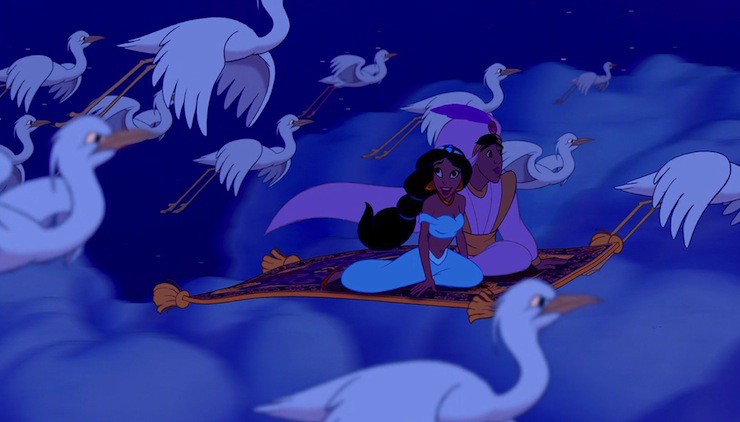
With two major songs dropped, the music was in chaos. The directors brought in Tim Rice, then well known for his work with Andrew Lloyd Webber on Jesus Christ Superstar and Evita. He was to later work with Disney on The Lion King. From Disney’s point of view, this was a wild success with at least one song, “A Whole New World,” which, combined with Alan Menken’s score (and, for the single, the voices of Peabo Bryson and Regina Bell) became a number one song in the U.S. The song also snagged an Academy Award and a Grammy Award.
From my point of view, this was a little less of a success, since I cannot make myself believe that people can fly to Egypt then China and back in the space of a few hours, magic carpet or no magic carpet, though the nod to China (the original setting of the story) is nice. But that’s probably an unfair criticism of the actual song, which continued to be a Disney staple years after this original release.
Rice’s other major contribution, “One Jump Ahead,” was less successful, and much less memorable. It’s meant, I think, to be similar to Belle’s introductory song in Beauty and the Beast, but something that doesn’t quite work as well—perhaps because it centers on Aladdin and Abu running around stealing things, instead of Belle’s desire to try to find a place where she belongs. Perhaps as a result, within the film, both Tim Rice songs tend to overshadowed by the Howard Ashman written “Friend Like Me,” focusing on the Genie, and the rollicking song “Prince Ali,” which, ok, technically is about Aladdin, but really is a chance for the Genie to show off and happily comment on the parade he’s created.
Or, given the popularity of “A Whole New World,” the real problem may not have been with the songwriters, but simply that in general, Aladdin just isn’t all that good until the Genie arrives, even with stunning animated sequences that were technologically far superior to anything Disney had created before, including a sequence with, for the first time in Disney history, animated backgrounds. Disney had come close to this in The Rescuers Down Under and Beauty and the Beast, and had already developed the computer assisted camera work allowing the camera to swoop and zoom, something that would be perfected in the opening sequence of their next film, The Lion King, but the animated backgrounds for two of the Cave of Wonders sequences were something new indeed.
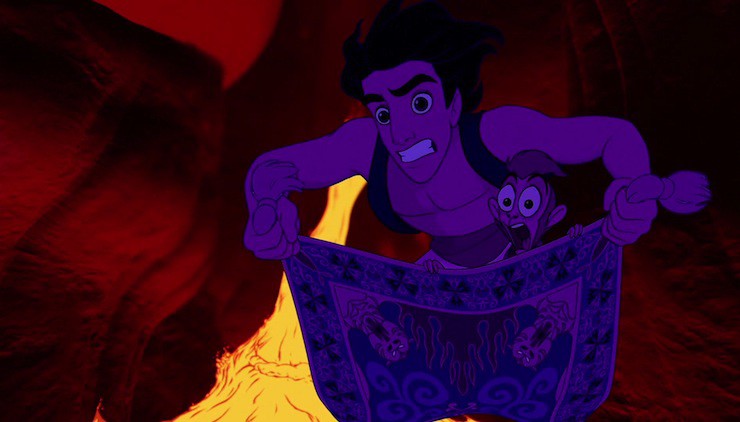
As was Aladdin’s high speed magic carpet ride through the collapsing Cave of Wonders—a dizzying (and I mean that in more than one sense) combination of hand drawn and computer animation, made possible by Disney’s CAPS (Computer Animation Production System) technology. And speaking of CAPS technology and what it allowed: a later sequence set in Jasmine’s bedroom, also created partly through CAPS, finally accomplished something Disney had wanted to do since Fantasia: allow us to see a room through shimmering, moving, gauze curtains—before moving the camera through the curtains to give us a clear look. In terms of beauty and art, Aladdin probably still lingers behind Beauty and the Beast; (though to be fair, Aladdin was also cobbled together much faster after the rewrites); in terms of technology, Aladdin managed to leave even its impressive predecessor far behind.
Perhaps even more impressively, these technological improvements managed to overcome a rather large logistical snarl: Disney executives once again insisting that animation for Aladdin proceed in two locations: the main California studio, and the smaller, newer Florida studio in what was then the Disney-MGM Studios Theme Park (now the Hollywood Studios Theme Park), as part of a tourist attraction. For Beauty and the Beast, different scenes had been assigned to the California and Florida studios, resulting in Belle not always looking like, well, Belle, which was a problem both for viewers and for future toy sales, which needed a single look. This time, Clements and Musker assigned different characters to the California and Florida studios – Aladdin, for instance, was animated in California, and Jasmine in Florida. That still created some logistical headaches, but with extensive use of fax machines, next-day delivery services, and the CAPS system, animators were far more successful in maintaining the same look for all characters throughout the film.
But despite these technological achievements, Aladdin only roars to life once the Genie comes on board—partly because, once he arrives, the stakes become much higher, and because once he arrives, Aladdin’s wistful hope to be something more than a street rat, and Jasmine’s angrier wish to see something more beyond the palace that entraps her and avoid an unwanted marriage, both become possible.
And mostly because with the Genie, Disney animators managed something awesome: animating a Robin Williams improv routine.
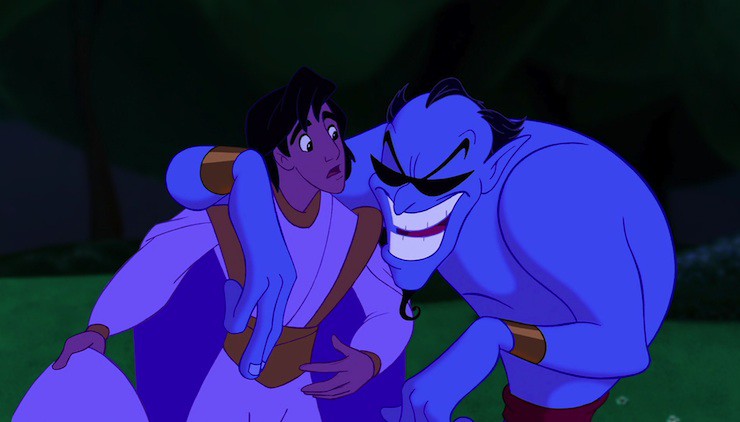
Williams was nearly always at his best when allowed to ad lib, rather than forced to stick with a script. Recognizing this, Disney simply handed Williams the lyrics for the songs and some general guidelines, and let Williams ad-lib everything else. Williams, after reading the guidelines, decided that what was really needed was celebrity impressions, eventually creating around 54 of them. though not all of the impressions made it into the final film.
It was brilliant, and dazzling. That said, as much as I love the Jack Nicholson and Groucho Marx impressions (in a great touch, the Genie turns black and white during the Groucho Marx bit), and as much as it pains me to admit it, I fear that this is also one part of a film that is already aging, with fewer viewers able to recognize, say, William Buckley or Arsenio Hall. On the other hand, some of the impressions—like the Peter Lorre bit, or, for that matter, the Arsenio Hall bit—work even without knowing the originals. And the final results create a multilayered creature constantly in shift, constantly borrowing from others. It also gives another layer to Aladdin’s decision to lie to Jasmine: it’s not just that Aladdin believes that Jasmine won’t want to be a street rat (and legally, won’t be able to be with him since she has to marry a prince), but the main person urging him to tell her the truth is someone who keeps shifting into multiple personas, rarely allowing himself to be himself.
It helps, too, that animators added some improvisation and in jokes of their own to the Genie—including references to Pinocchio, The Little Mermaid (poor Sebastian makes a quick, startled appearance), Beauty and the Beast, and Walt Disney World tourists, and in particular, WDW tourists wearing Goofy hats, looking rather like a certain comedian who occasionally visited WDW.
Animators did much less with Gilbert Gottfried’s Iago the parrot, but had quite a lot of fun with Abu, Aladdin’s pet monkey turned elephant, and the voiceless magic carpet, who after an initial bit of shyness, turns into a heroic magic carpet that is also eager to have Aladdin tell the truth—that he’s nothing more than a street rat with a fabulous lamp. They also, more tentatively, decided to try to animate a tiger again. Unfortunately, although computer assisted animation had managed wonders for backgrounds, camera movements, and creating the illusion of a camera speeding through paintings, it had not yet reached the point where it could make animating stripes easy or cheap. As a result, the tiger was eliminated from several scenes, and made to sit very quietly, only moving his head, in others. Animators over on The Lion King hastily reduced the number of zebras.
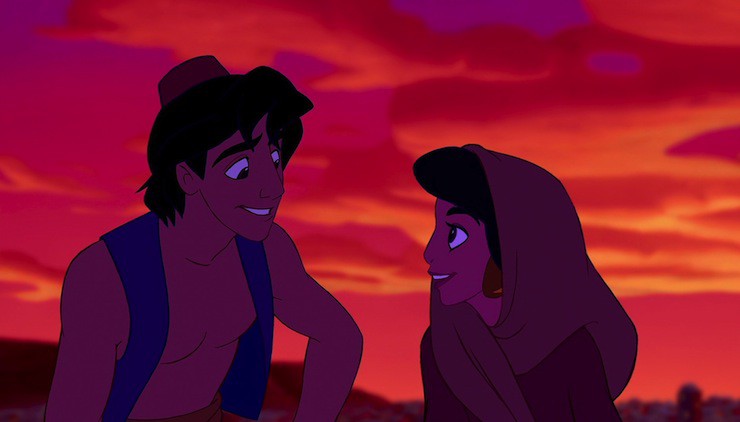
Compared to these side characters, main characters Aladdin and Jasmine feel a bit, well, bland. That characterization is perhaps unfair to both. Jasmine follows in the footsteps of Ariel and Belle as someone unhappy with the restrictions of her world and her lack of choices: like both of them, she takes active steps to change this, and it’s not entirely her fault that she’s a secondary character in a film not all that interested in her, to the point where she was even drawn in what was then the secondary animation studio, Florida. She’s perceptive, and fast thinking, but this isn’t her movie, and in the end, although she does get to choose her own husband, she doesn’t really get a chance, like Ariel and Belle, to move out of her world. She can be shown the world, but she stays in her palace.
Jasmine’s story does have a hint of another, more interesting story, that never does get explored thanks to the decision to turn Aladdin into high comedy: that is, the idea that enclosing yourself behind walls can make you more vulnerable, not less. Because Jasmine has never left the palace walls, she knows nothing about things like money, which almost immediately gets her into trouble. Her father, who has apparently also never left the palace, is easily tricked by Jafar. It takes someone born outside the walls to save them both.
That someone, of course, is otherwise bland protagonist Aladdin, who stands out among Disney protagonists only because he’s one of the few protagonists to start off with somewhat questionable morals. But as Aladdin shows, its protagonist is only one of many poor people living in the shadows of the palace, pretty much all of whom, like the villain Jafar, have slightly darker skin than the palace inhabitants. The original story blamed Aladdin’s poverty on inherent laziness. In the film, Aladdin makes a fairly convincing argument that he’s been forced into a life of petty larceny: he has no other skills, and no one seems interested in hiring him. The film doesn’t exactly agree with this – we never see Aladdin applying for a job, for instance, and throughout the film, Aladdin takes the easy way out whenever possible — but the presence of other pathetic children with huge eyes grateful to eat garbage suggests that Aladdin’s excuse may not be completely off the mark. And of course, the skills he gains through his life of poverty, outside the protection of the palace walls, allows him to save Jasmine and her father, even if he’s not quite clever enough to keep his magical lamp on him at all times.
And of course, Jafar uses that lamp, that poverty, and those lies to take over the kingdom. It’s a sorta mixed message, is what I’m saying.
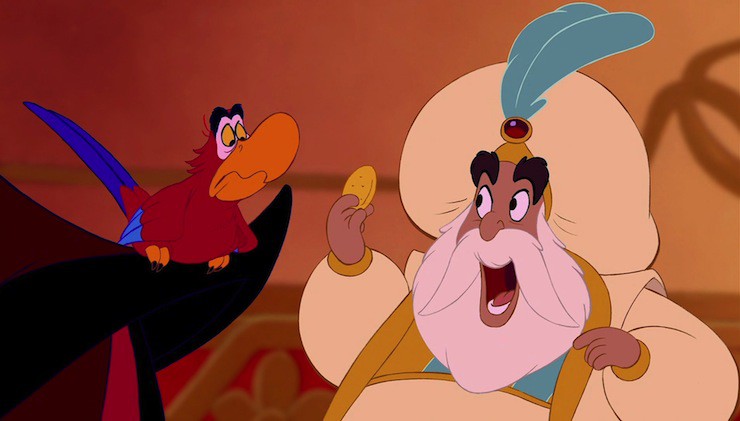
I have other quibbles. For instance, I realize in that Iago the Parrot is not the nicest sort of parrot, but I am still not certain that he actually deserves the evil fate of getting trapped for all eternity in a small lamp with Jafar, especially since Jafar, not Iago, is the one getting the ULTIMATE COSMIC POWERS and Iago just gets the itty leetle living space. And I definitely don’t think that Iago did anything terrible enough to justify forcing him to come back for the sequel, The Return of Jafar, but then again, that’s true for pretty much all of the characters.
Also, a question: given that Aladdin only had three wishes, and two of them had already been used up, would poor Abu have remained an elephant if Jafar hadn’t transformed him back to a monkey? (After all, Aladdin really only had two choices with that third wish—turn into a prince, or free the Genie—neither one of which would have been terribly helpful to Abu. If Abu had been forced to stay an elephant, would he ever have been able to eat a banana again? And what happened to all of the other transformed creatures that entered the city with Aladdin? A deleted scene suggests that all of them were originally cockroaches, rats and other vermin, so they might have been able to blend in quite easily with the rest of humanity. I hope so, since we never see Jafar or the Genie restore their original forms.
Others, most notably the American-Arab Anti-Discrimination Committee, had more serious objections, both to the portrayals of many of the minor characters in the film, and to the lyrics in the opening song. In response, Disney altered the lyrics in the first song from “Where they cut off your ear if they don’t like your face,” to “Where it’s flat and immense and the heat is intense,” but did not alter the portrayals of the other characters until the creation of the Disney Princess franchise, when Disney began creating more costumes for the Jasmine Princess doll.
Disney also ran into trouble with Robin Williams, who had agreed to do the film at far below his usual rates—as long as Disney did not use his name while marketing and promoting the film. Disney did use his name, leading to a feud that ended only when Joe Roth, who had replaced Jeffrey Katzenberg as the Chairman of Walt Disney Studios, publicly apologized.
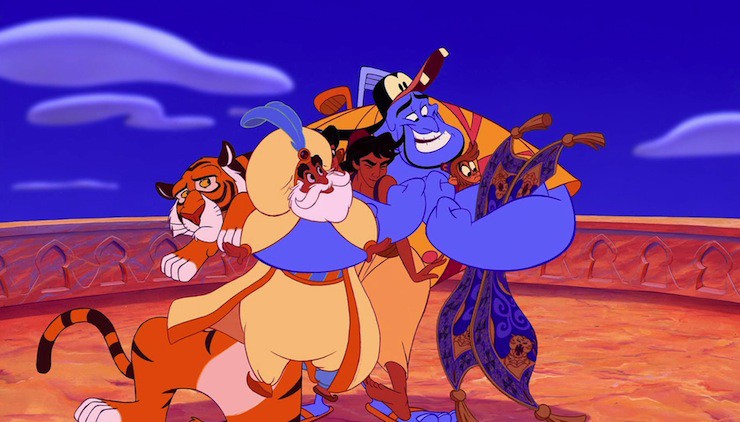
Despite these issues, Aladdin was a major box office success, outgrossing every other film released in 1992, and earning more than any other animated feature up until that time (a record defeated by The Lion King in the following year.) Disney released two generally terrible direct to video sequels, as well as an animated series called Aladdin, where, I’m happy to tell you, Iago the parrot is no longer trapped in the lamp, but also where, I’m sorry to tell you, he’s reformed and a lot less fun. Aladdin also spawned the “Magic Carpets of Aladdin” ride at Walt Disney World and Disneyland Paris, several video games, and a Broadway musical. Jasmine became one of the original Disney Princesses, and continues to make regular appearances at Disney Princess events.
Next up, against my better judgment, The Lion King.
Mari Ness lives in central Florida.










